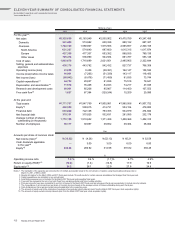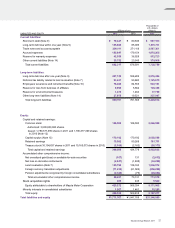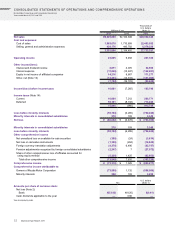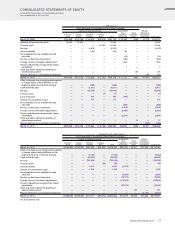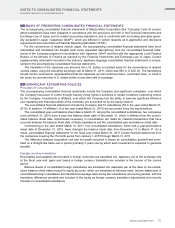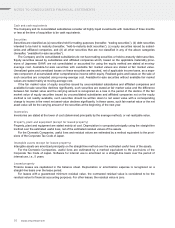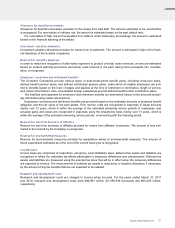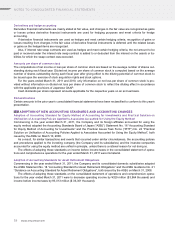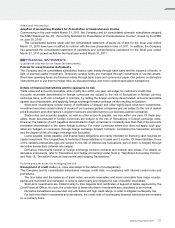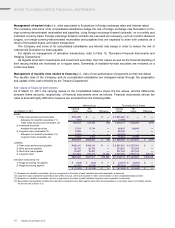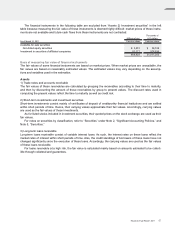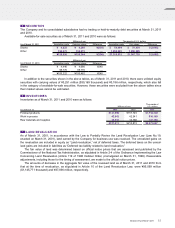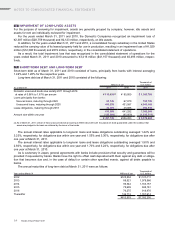Mazda 2011 Annual Report Download - page 58
Download and view the complete annual report
Please find page 58 of the 2011 Mazda annual report below. You can navigate through the pages in the report by either clicking on the pages listed below, or by using the keyword search tool below to find specific information within the annual report.
Cash and cash equivalents
The Company and its consolidated subsidiaries consider all highly liquid investments with maturities of three months
or less at the time of acquisition to be cash equivalents.
Securities
Securities are classified as (a) securities held for trading purposes (hereafter, “trading securities”), (b) debt securities
intended to be held to maturity (hereafter, “held-to-maturity debt securities”), (c) equity securities issued by subsid-
iaries and affiliated companies, and (d) all other securities that are not classified in any of the above categories
(hereafter, “available-for-sale securities”).
The Company and its consolidated subsidiaries do not have trading securities or held-to-maturity debt securities.
Equity securities issued by subsidiaries and affiliated companies which, based on the applicable materiality provi-
sions of Japanese GAAP, are not consolidated or accounted for using the equity method are stated at moving-
average cost. Available-for-sale securities with available fair market values are stated at fair market value.
Unrealized gains and unrealized losses on these securities are reported, net of applicable income taxes, as a sepa-
rate component of accumulated other comprehensive income within equity. Realized gains and losses on the sale of
such securities are computed using moving-average cost. Available-for-sale securities without available fair market
values are stated mainly at moving-average cost.
If the fair market value of equity securities issued by unconsolidated subsidiaries and affiliated companies and
available-for-sale securities declines significantly, such securities are stated at fair market value and the difference
between fair market value and the carrying amount is recognized as a loss in the period of the decline. If the fair
market value of equity securities issued by unconsolidated subsidiaries and affiliated companies not on the equity
method is not readily available, such securities should be written down to net asset value with a corresponding
charge to income in the event net asset value declines significantly. In these cases, such fair market value or the net
asset value will be the carrying amount of the securities at the beginning of the next year.
Inventories
Inventories are stated at the lower of cost (determined principally by the average method), or net realizable value.
Property, plant and equipment (except for leased property)
Property, plant and equipment are stated mainly at cost. Depreciation is computed principally using the straight-line
method over the estimated useful lives, net of the estimated residual values of the assets.
For the Domestic Companies, useful lives and residual values are estimated by a method equivalent to the provi-
sions of the Corporate Tax Code of Japan.
Intangible assets (except for leased property)
Intangible assets are amortized principally on the straight-line method over the estimated useful lives of the assets.
For the Domestic Companies, useful lives are estimated by a method equivalent to the provisions of the
Corporate Tax Code of Japan. Software for internal use is amortized on a straight-line basis over the period of
internal use, i.e., 5 years.
Leased property
Finance leases are capitalized in the balance sheet. Depreciation or amortization expense is recognized on a
straight-line basis over the lease period.
For leases with a guaranteed minimum residual value, the contracted residual value is considered to be the
residual value for financial accounting purposes. For other leases, the residual value is zero.
NOTES TO CONSOLIDATED FINANCIAL STATEMENTS
56 Mazda Annual Report 201 1




